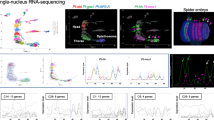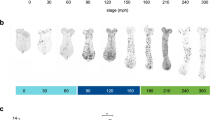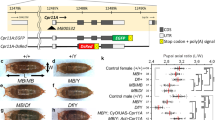Abstract
In many insects the larval cuticle pattern changes at metamorphosis to one of transverse ripples, often with a shortening of the segments (for example, Rhodnius, Hemiptera1; Calpodes, Lepidoptera; Tenebrio, Coleoptera2). The orientation of these ripples in Rhodnius was used to discover a segmentally repeating gradient of positional information3. Since then there has been much work onthe gradient4–6 but little on the mechanism by which an epidermal cell controls the cuticle pattern that allows us to read its orientation in the gradient. We report here that in the larval/pupal transformation of Calpodes and other insects, the epidermis develops basal cytoskeletal extensions or feet, oriented in the direction of the gradient at right angles to the ripples. Their contraction coincides with segment shortening and transverse ripple formation. Epithelial cells of the integument are not always packed together like polygonal paving stones as they are usually depicted, but may relate to one another by cytoskeletal extensions of a kind that are more usually reported from separate moving cells in tissue culture. Such epidermal feet may have general relevance in morphogenesis.
This is a preview of subscription content, access via your institution
Access options
Subscribe to this journal
Receive 51 print issues and online access
$199.00 per year
only $3.90 per issue
Buy this article
- Purchase on SpringerLink
- Instant access to full article PDF
Prices may be subject to local taxes which are calculated during checkout
Similar content being viewed by others
References
Wigglesworth, V. B. W. J. exp. Biol. 17, 201–222 (1940).
Williams, G. J. A. & Caveney, S. J. Embryol. exp. Morph. 58, 13–33, 35–61 (1980).
Locke, M. J. exp. Biol. 36, 459–477 (1959); 37, 398–406 (1960).
Lawrence, P. A. in Developmental Systems: Insects Vol. 2 (eds Counce, S. J. & Waddington, C. H.) (Academic, New York, 1973).
Crick, F. Nature 255, 420–422 (1970).
Lawrence, P. A., Crick, F. H. & Munro, M. J. Cell Sci. 11, 815–853 (1972).
Locke, M. & Huie, P. Tissue Cell 13, Pt 4 (1981).
Whitten, J. M. Science 181, 1066–1067 (1973).
Wigglesworth, V. B. W. J. Cell Sci. 26, 161–174 (1977).
Wigglesworth, V. B. W. Q. Jl microsc. Sci. 95, 115–137 (1954).
Wigglesworth, V. B. W. J. exp. Biol. 36, 632–640 (1959).
Dean, R. L., Bollenbacher, W. E., Locke, M., Smith, S. L. & Gilbert, L. I. J. Insect Physiol. 26, 267–280 (1980).
Berger, E. M., Sloboda, R. D. & Ireland, R. C. Cell Motility 1, 113–129 (1980).
Cherbas, L., Yonge, C. D., Cherbas, P. & Williams, C. M. Wilhelm Roux Arch. EntwMech. Org. 189, 1–15 (1980).
Locke, M. in Metamorphosis 2nd edn (eds Frieden, E. & Gilbert, L. I.) 75–103 (Plenum, New York, 1981).
Gustafson, T. & Wolpert, L. Expl Cell Res. 24, 64–79 (1961); Biol. Rev. 42, 442–498 (1967)
Author information
Authors and Affiliations
Rights and permissions
About this article
Cite this article
Locke, M., Huie, P. Epidermal feet in insect morphogenesis. Nature 293, 733–735 (1981). https://doi.org/10.1038/293733a0
Received:
Accepted:
Issue date:
DOI: https://doi.org/10.1038/293733a0
This article is cited by
-
From bristle to brain: embryonic development of topographic projections from basiconic sensilla in the antennal nervous system of the locust Schistocerca gregaria
Development Genes and Evolution (2024)
-
Ontogeny of pioneer neurons in the antennal nervous system of the grasshopper Schistocerca gregaria
Development Genes and Evolution (2017)
-
Delta-promoted filopodia mediate long-range lateral inhibition in Drosophila
Nature (2003)
-
Tracheole migration in an insect wing
Wilhelm Roux's Archives of Developmental Biology (1984)



